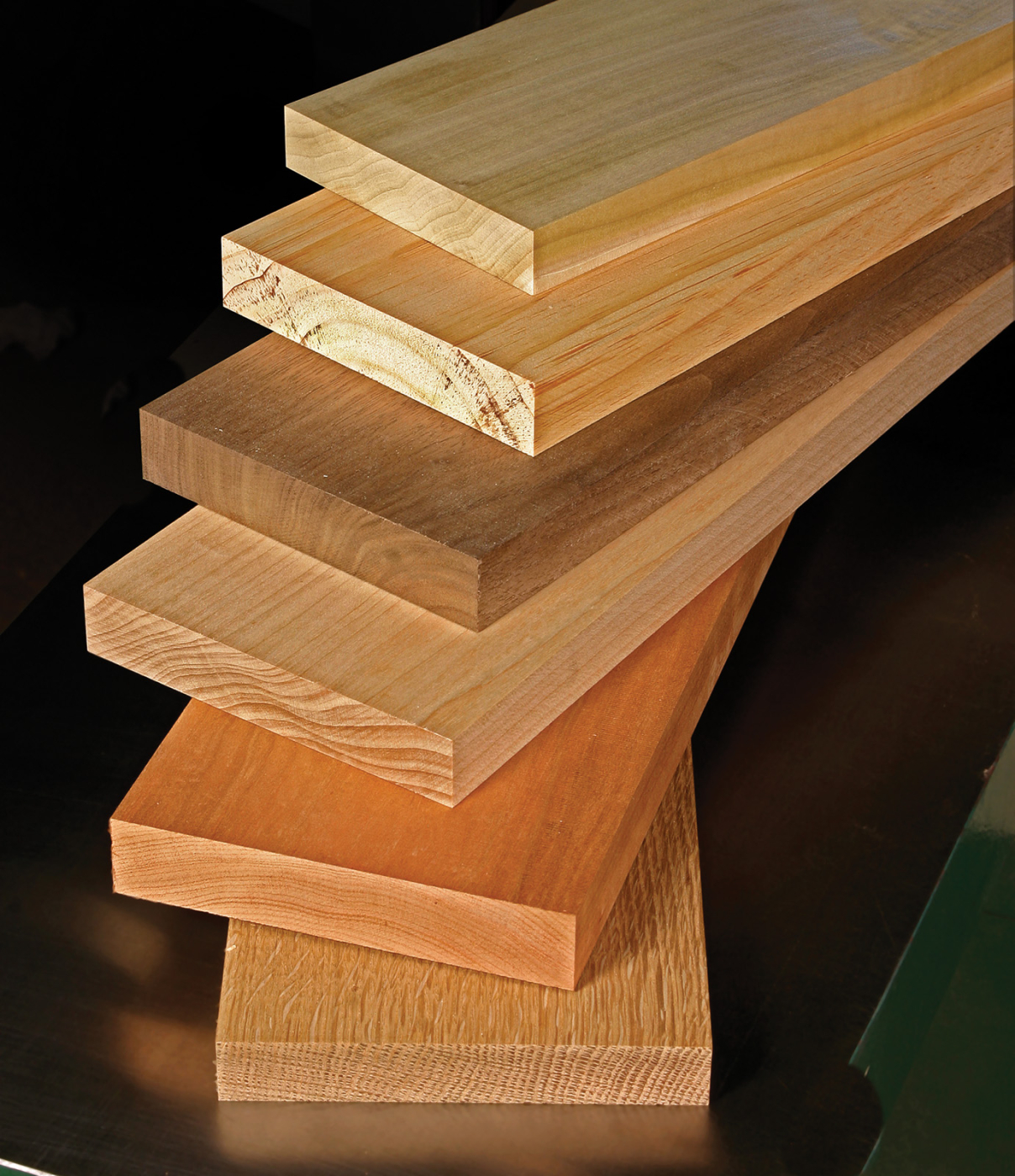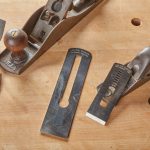We may receive a commission when you use our affiliate links. However, this does not impact our recommendations.

Character. Every piece of wood is an individual, and its appearance is determined by where it was located in the log.
The end grain holds the secret to what stock to use where.
The single-most important factor in the appearance of any woodworking project is the selection of the material. This isn’t what species to use or what color of finish; it is the choice of which board goes where. The wrong grain pattern in the wrong location can make even the most finely crafted piece look like junk.
While appearance is always subjective, there are traditional approaches to grain placement and orientation that are based on how wood behaves over time. In the grand scheme of things, these arrangements also appear harmonious to our eyes.
This is similar to music. You may want to write a non-traditional song, but the best-sounding notes and chords will be those that have evolved and been used for centuries. Good furniture design, regardless of style, calls for arranging the wood in ways that make sense both visually and structurally.
The key to understanding how any individual piece of wood will appear and function stems from where that piece of wood was when it was in the tree. It is rather simple to discover that by examining not the face, but the end of an individual board.
Moisture Matters
A living tree contains a lot of water, and when it is cut down and made into lumber that water migrates into the atmosphere. As the water leaves, the cells shrink first as the water within the cells disperses. Then the cell walls lose their moisture, and in the process the cells get smaller and change shape.
This is what causes lumber to warp as it dries, and the vast majority of warpage occurs during the initial drying process. Wood will always be in the process of releasing or absorbing moisture in response to changes in the environment.
Properly dried and conditioned wood won’t likely change shape after milling, unless it is subjected to extremes of humidity. The Architectural Woodworking Institute’s “Quality Standards” recommends keeping relative humidity between 25 percent and 55 percent to avoid problems.
This includes the storage of lumber before milling, the conditions of the shop during project fabrication and the environment where the finished piece will be placed. Extreme levels of relative humidity, less than 20 percent or higher than 80 percent, are likely to cause problems. If you work within these guidelines, problems related to wood movement aren’t likely to occur.
Even so, it is essential to understand what direction any piece of wood you use will move, and the consequences of that movement. Tradition is here to help you out, and if you follow tradition the chances of your finished project looking good are greatly increased.
Consider the Source
There are three main classifications of lumber, based on the pattern of the end grain on the board. These patterns are related to where the board was in the log. As wood dries, most of the shrinkage is in the circumference of the growth rings across the grain. Imagine the rings as elastic bands that have been stretched out. As they contract, each ring gets smaller, and longer rings in a board influence shorter rings adjacent to them.
 Plain-sawn lumber is most likely to warp, twist and cup, because the concentric rings are disproportionately dispersed through the board. Trees are larger at the bottom than at the top, so the ring patterns taper along the length of a board. When the flat surface produced by milling crosses the tapered rings, it produces an arched pattern on the face, commonly called a “cathedral.”
Plain-sawn lumber is most likely to warp, twist and cup, because the concentric rings are disproportionately dispersed through the board. Trees are larger at the bottom than at the top, so the ring patterns taper along the length of a board. When the flat surface produced by milling crosses the tapered rings, it produces an arched pattern on the face, commonly called a “cathedral.”

Plain-sawn. Growth rings that arch across the end of a board create “cathedral” shapes on the face of the board. While attractive, plain-sawn lumber is most likely to cup or twist.
Quartersawn and rift-sawn lumber are more stable, both in initial drying and over time because the arrangement of the rings is more consistent throughout the board. The trade-off is in appearance; quartersawn and rift-sawn lumber exhibit straighter and tighter grain lines than plain-sawn material.

Rift-sawn. The growth rings slant across the end of rift-sawn lumber. The grain pattern on the faces and edges is straight and this cut is stable.

Quartersawn. The growth rings in quartersawn lumber are vertical, or nearly so. This type of wood will move more in thickness than in width.
Most boards will have a combination of grain patterns. Plain-sawn faces show quarter sawn edges and vice versa. Rift-sawn boards will have straight grain on both the faces and edges. In many boards, the grain pattern will change across the width, with a rift-sawn pattern on one side and a plain-sawn pattern on the other.

Lumber can’t read. Most pieces of wood will have a combination of grain patterns, with a different appearance on one side of the face than the other.
As Wide as You Can
Much of what is written about using wide pieces of lumber only applies if you’re using material that is either not yet dry, or in the process of reaching equilibrium to a dramatic change in environment. If your wood is dry, at equilibrium with your shop environment, and conditions in the shop are close to those of your house, there is no good reason not to use wide boards for panels, case sides or tabletops.
Ripping wide boards and gluing them back together, with or without flipping them over (as you may have heard suggested), won’t do a thing but waste your time and make your project uglier than it ought to be. That technique entered the literature as a way for factories to minimize the problems that come from using substandard and improperly dried material.
Wide pieces are often the most visible in a project, so you should take extra care in selecting the wood if you need to glue up a workpiece from narrower stock. The goal is to make the glued-up piece look as much as possible like a single board. Plan these glue-ups first as you select your material. Often you can use two rift-sawn (or partially rift-sawn) pieces on either side of a plain-sawn piece.
Generally speaking, wood looks nicest if it is placed in furniture in the same orientation that it had in the tree. On plain-sawn pieces, orient the cathedrals so that they all point up, and arrange adjacent panels so that the upper peaks are at about the same level.
For the outer elements of pieces, orient the grain with the widest spacing at the bottom; if the grain slants, make each side slope toward the middle. This will give your furniture a solid stance; it won’t look as if it is leaning to one side.
On the Straight & Narrow

Harmonious composition. Rift or quartered lumber for the stiles and rails and a plain-sawn panel make an attractive and stable door. Even if glued from more than one piece, panels look best with this grain pattern.
Door frames and other frames are the ideal place to use quartersawn or rift-sawn material. The narrower, straight grain won’t detract visually from the panel, and the stability of this material is good insurance to keep things straight – regardless of what happens environmentally.

Disturbing noise. Wild grain, or grain running off the side of stiles and rails, detracts from the panel and the overall look. Mismatched panels should be avoided.
Rift-sawn material is also the best choice for legs or other square elements. The straight grain will look good from the front and the side. If you use quartersawn or plain-sawn material in this circumstance, you’ll have to choose between a nice front or a nice side – you can’t have both. This is especially important if the legs are carved or turned. The straight grain will make those tasks easier, and the finished appearance will be similar when viewed from any angle.
Here are some supplies and tools we find essential in our everyday work around the shop. We may receive a commission from sales referred by our links; however, we have carefully selected these products for their usefulness and quality.









